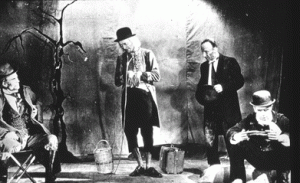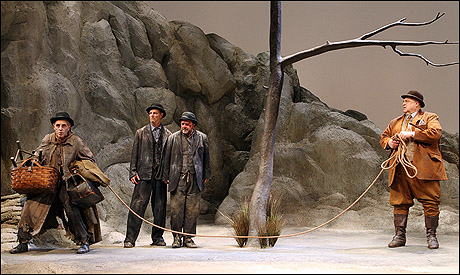Beckett’s setting for Waiting for Godot (En antendant Godot) is an empty stage and a tree without leaves. It’s an unlikely place for an unhappy picnic.

Roger Blin. Waiting for Godot. (1953). Theatre de Babylone, Paris. This production was performed on a cramped stage intended to make the audience uncomfortable. Photo by Boris Lipnitzki.
The picnic begins when Pozzo and Lucky arrive. Pozzo brandishes a whip and holds Lucky at the end of a long heavy rope, like a packhorse laden with a wicker, a valise, an overcoat, and a campstool. Lucky can barely stand. Astounded, Vladimir and Estragon cozy up to Estragon in hopes of joining his picnic. But they only watch, hoping to glean some scraps from Lucky’s “picnic basket” [panier à provisions], as Lucky serves Pozzo wine and cold chicken. It’s a miserable meal, and while Pozzo eats with gusto, he does not share with Lucky.
When Pozzo finishes, he throws his chicken bones on the ground. Catlike, Estragon pounces and gnaws them as if eating real flesh. Selfishly, he does not share his “bounty” with his pal Vladimir.
Featured Image: Beckett might have considered the mountain ridge in this setting too ornate. Anthony Page. Waiting for Godot. Roundabout Theatre: New York (2009). Set design by Tom Watson. Four picnickers: Lucky (John Glover), Vladimir (Bill Irwin), Estragon (Nathan Lane), and Pozzo (John Goodman). Photo by Joan Marcus.
See Samuel Beckett. Waiting for Godot, a Tragicomedy in Two Acts. New York: Grove Press, 1954.

